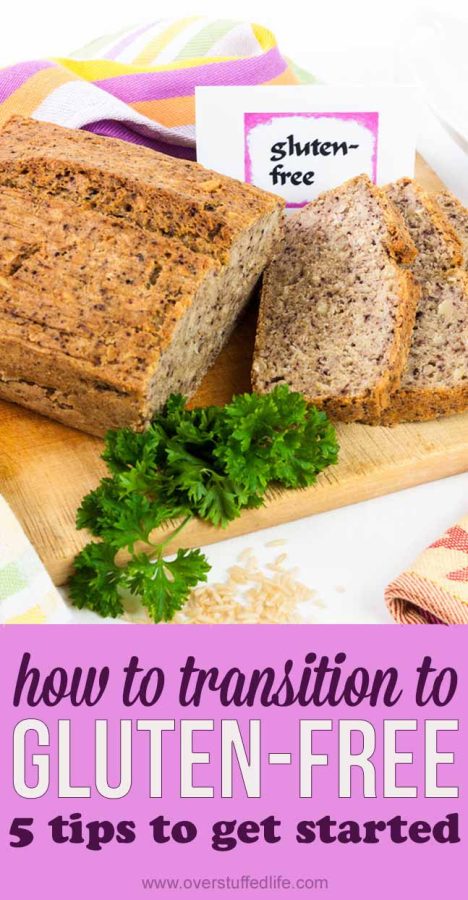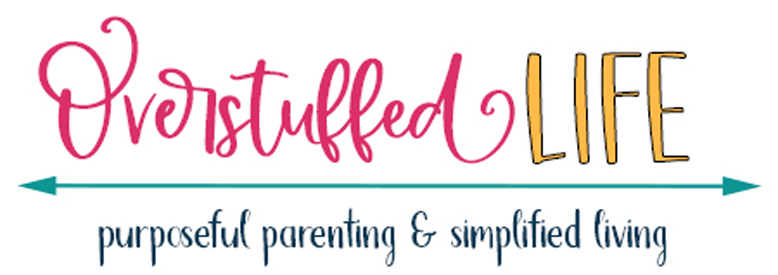Five Tips to Help You Transition to Gluten-Free
Have you recently received a diagnosis that requires you to eat gluten-free? Whether it is Celiac Disease, Hashimotos, or something else, transitioning to gluten-free is a process. Follow these five tips and make your transition to a gluten-free diet painless.

Gluten-free life has begun to take the members of our household down one by one. Okay, that was a little dramatic—it’s actually been a really good thing! But it did take me several weeks of research, and a lot of trial and error before I felt I really had a handle on things. Here are some of my best tips for making the transition easier.
How to Transition to a Gluten-free Diet
1. Don’t Be Discouraged!
Whether you’ve just received a diagnosis of Celiac or another auto-immune disease, or are eliminating gluten for other reasons, the prospect of so drastically changing your diet is daunting. It is super easy to start focusing on all of the things you can’t have and when you do, it feels like you’ll never be successful. Let’s face it, the American diet is so based in wheat that getting rid of that one tiny little grain feels impossible.
But it isn’t! It is totally possible.
There are so many products now available that you can walk into most grocery stores and come out with plenty of gluten-free alternatives to the bread and crackers you are used to eating. It’s much, much easier than it used to be.
Another point of discouragement can be that you don’t immediately feel better after starting your new diet. In fact, you can often feel worse. Don’t worry! You will feel better, but it takes time for the body to heal from gluten damage, and it takes time for you to detoxify. It can be hard for the first couple of weeks but hang in there because it is so very worth it.
2. Plan Meals That Don’t Include ANY Grains.
Even though there are a million and one gluten-free products out there, try not to use too many in the beginning. Start planning meals that don’t include wheat OR wheat substitutes, or, in fact, any grains at all. You have plenty of time to figure out what’s out there to stand in for wheat; right now is the time to focus on the foods you can always eat without worrying about substitutes.
Focus on fruits, vegetables, meats, fish, eggs, nuts, healthy fats, and even dairy. I like to turn to Paleo recipes (they are grain and dairy free) to give me ideas. The possibilities are endless, and it will give you a lot of confidence in cooking without wheat.
Typically dinner is the easiest meal to do this with. We rely so much on our cereal and our sandwiches for breakfast and lunch that planning those meals can be more difficult. Do it anyway. You will be amazed at the great meals you can have for breakfast without eating cereal, pancakes, toast, or waffles. Same goes for lunch—make yourself a tasty salad and enjoy every bite! Use oil and vinegar for dressing and you won’t even have to worry whether the dressing is gluten-free or not.
It is freeing to realize you can prepare several meals and not have to worry one bit about how to make them gluten-free.
3. Become a Label Reader.
When I say become a label reader, what I really mean is become a label reading fanatic. Do not eat anything that comes in a box, a can, or a bag without reading the label first! Gluten hides in the unlikeliest of places and has many different names.
Recently, I was making my eldest daughter’s birthday meal, and she had requested my famous green chile chicken enchiladas. I rarely make this meal, and I definitely hadn’t made it since my youngest daughter’s celiac diagnosis. I went and bought the ingredients, including some GF brown-rice tortillas to substitute for flour, but I didn’t bother to read the labels while I was in the store. I did read the label on the enchilada sauce before I opened the can and was shocked to find that it contained gluten. I really didn’t anticipate that at all, but I am so glad I checked because had my daughter eaten that enchilada sauce she would have been sick for days.
Gluten likes to hide in cream soups, licorice, anything containing caramel coloring, and, apparently enchilada sauce. Read those labels.
I have a great free app on my iPhone called The Gluten Free Scanner which tells me which products contain gluten and which don’t. Remember, gluten goes by many names, and if there is anything in an ingredient list you aren’t sure of, look it up!
4. Budget.
Once you do begin to use the gluten-free products that are out there, you might experience some sticker shock. According to this study, gluten-free foods are, on average, 242% more expensive than their gluten-full counterparts. Now that most of our family is GF, our grocery bill has gone up by about 25% and I don’t even typically buy all the gluten free things available. I usually buy a small loaf of Udi’s GF bread and a bag of Glutino bagels each week, and I try to keep my pantry stocked in different gluten-free flours. But when you compare that tiny loaf of bread that I purchase for $4.95 with the much bigger loaf of wheat bread that I can get for $1.98 you can see how your grocery bill can get out of hand if you’re not careful. The bag of bagels also runs around $4.50 compared to $1.50 for a bag of bagels made with wheat flour. (2016 prices)
One of my kids begged me to buy her a bag of Glutino brand pretzels to take on a Girl Scout trip. An 8 ounce bag cost me $6.99—and that was on sale! Ouch. But it was important that she have some snacks for the trip that worked for her, so I bought it anyway.
Wheat is cheap. Its substitutes are not. Budget for what you cannot live without and do your best to live without the rest, or purchase them only on very special occasions (like Girl Scout road trips).
5. Plan Ahead.
One of the most difficult things about maintaining a gluten-free diet is that the rest of the world isn’t going to do it with you. Wheat will still be in everything. I go to social gatherings expecting that I will be able to eat exactly 0% of the food that is provided. Fortunately, I have some amazing friends who really try to look out for me and provide something that I can eat, but that isn’t always the case.
Eat before you attend a party, and if you want to eat something while at the party, bring it yourself. I always make a GF something to bring to social gatherings so I can eat it myself, but the bonus is that many people find out how good gluten-free treats can be! I’m helping to eradicate the stigma that gluten-free = tasteless, one party at a time.
For my children it is even harder. I take a box of GF cookies to be kept in their classroom so that when another child is celebrating his/her birthday, my child can also have a treat. Obviously, when I bring something into the classroom for a Halloween party or for my own child’s birthday, it is gluten-free. When my children are invited to birthday parties, I call the other parent and explain the dietary restrictions. I always bring something for my child to eat at the party in place of birthday cake. Some parents have been amazing at providing alternatives for my child, but others appreciate that I will bring it in.
Eating gluten-free also means that you won’t typically be able to eat convenience food, whether that’s at a fast food restaurant or a grab-and-go granola bar. If you’re used to eating on the run, you’ll need to slow down and start planning and preparing your meals in advance. Or budget for the fast gluten-free food that’s out there.
It’s definitely a huge change, but don’t lose sight of the amazing benefits you will reap through your hard work. After a few months, eating gluten-free will feel very normal, and dare I say it? Easy.
You can do it!
How to Make a Gluten-free Pie Crust + Delicious Pear Pie

This post may contain affiliate links, for more information, please see my disclosure.




Man, I could have written this and substituted peanut/tree nut free for gluten. The same rules apply for the most part. I wish, wish, I could send you some good green chile from NM. There is no gluten in the fresh stuff here. But, a national brand that you can buy online and perhaps in your store is "Frontera Green Chile Enchilada Sauce". Fontera is the company of Chef Rick Bayless. All of his products are great. I just read the label of the packet I have in my pantry — no gluten!
I truly love your blog.. Very nice colors & theme. Did you make this website yourself?
Please reply back as I'm hoping to create my own website
and would like to learn where you got this from or what the theme is named.
Appreciate it!
my website; work from home st. paul